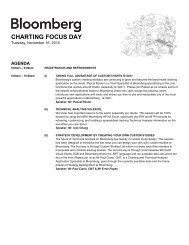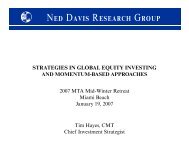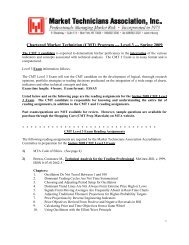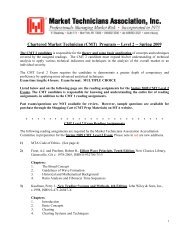Journal of Technical Analysis - Market Technicians Association
Journal of Technical Analysis - Market Technicians Association
Journal of Technical Analysis - Market Technicians Association
You also want an ePaper? Increase the reach of your titles
YUMPU automatically turns print PDFs into web optimized ePapers that Google loves.
22<br />
It’s important to note when using the VPCI that volume leads or precedes price action. Unlike most indicators, the VPCI will <strong>of</strong>ten give indications before price<br />
trends are clear. Thus, when a VPCI signal is given in an unclear price trend, it is best to wait until one is evident. At Point 1 in Chart 3, TM - Toyota Motor, is breaking<br />
out <strong>of</strong> a downtrend and the VPCI confirms this breakout immediately as the VPCI rises, crossing over the VPCI smoothed and then the zero line. This is an example <strong>of</strong><br />
VPCI’s bullish confirmation <strong>of</strong> a price trend. Later, the VPCI begins to fall during the uptrend, suggesting complacency. By Point 2, the VPCI crosses under the VPCI<br />
smoothed warning <strong>of</strong> a possible pause within the new uptrend. This is a classic example <strong>of</strong> a VPCI bearish contradiction. Before we reach Point 3, the VPCI makes an<br />
interesting pattern forming a “V” bottom. This is a bullish sign, <strong>of</strong>ten indicating the sell <strong>of</strong>f has washed out many <strong>of</strong> the sellers. Later at Point 3, the VPCI confirms the<br />
earlier bullish “V” pattern with a bullish crossover leading to a strong bull rally.<br />
Chart 4 The VPCI predicted the last major market pullback in May 2006<br />
Comparing the VPCI to other Price Volume Indicators<br />
There are many price volume indicators one could use to compare the VPCI to. However, the most acclaimed is Joe Granville’s original on-balance volume<br />
(OBV) indicator. 9 Recognizing volume as the force behind price, Granville, created OBV by assigning up days as positive volume (measured by an up close) and then<br />
subtracting volume on down days. OBV is price-directed volume, the accumulation <strong>of</strong> +/- volume flows based upon price direction. Granville’s original objective<br />
with on-balance volume was to uncover hidden coils in an otherwise non-eventful, non-trending market. 10 With his OBV indicator, Joe Granville, became a renowned<br />
market strategist. In so doing, he popularized OBV and the wisdom <strong>of</strong> using volume in securities analysis. Now, OBV is a standard application on charting s<strong>of</strong>tware<br />
and there are many OBV practitioners. However, few are able to interpret the indicators indications as competently as Granville.<br />
The VPCI differs from OBV in that it calculates the proportional imbalances between price trends and volume- weighted price trends. This exposes the influence<br />
volume has upon a price trend. Although both contain volume- derived data, they convey different information. In composition, the VPCI is not an accumulation<br />
<strong>of</strong> history like OBV but rather a snapshot <strong>of</strong> the influence <strong>of</strong> volume upon a price trend over a specified period <strong>of</strong> time. This enables the VPCI to give faster signals<br />
than accumulation indicators similar to an oscillator. In contrast to OBV, the VPCI’s objective is not to uncover hidden coils in trendless markets, but to evaluate the<br />
health <strong>of</strong> existing trends.<br />
Chart 5 VPCI / OBV comparison<br />
Jo u r n a l <strong>of</strong> <strong>Technical</strong> <strong>Analysis</strong> • 2008 • Issue 65

















